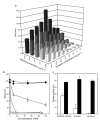Self-assembled micellar nanocomplexes comprising green tea catechin derivatives and protein drugs for cancer therapy
- PMID: 25282044
- PMCID: PMC4221637
- DOI: 10.1038/nnano.2014.208
Self-assembled micellar nanocomplexes comprising green tea catechin derivatives and protein drugs for cancer therapy
Abstract
When designing drug carriers, the drug-to-carrier ratio is an important consideration, because the use of high quantities of carriers can result in toxicity as a consequence of poor metabolism and elimination of the carriers. However, these issues would be of less concern if both the drug and carrier had therapeutic effects. (-)-Epigallocatechin-3-O-gallate (EGCG), a major ingredient of green tea, has been shown, for example, to possess anticancer effects, anti-HIV effects, neuroprotective effects and DNA-protective effects. Here, we show that sequential self-assembly of the EGCG derivative with anticancer proteins leads to the formation of stable micellar nanocomplexes, which have greater anticancer effects in vitro and in vivo than the free protein. The micellar nanocomplex is obtained by complexation of oligomerized EGCG with the anticancer protein Herceptin to form the core, followed by complexation of poly(ethylene glycol)-EGCG to form the shell. When injected into mice, the Herceptin-loaded micellar nanocomplex demonstrates better tumour selectivity and growth reduction, as well as longer blood half-life, than free Herceptin.
Figures





References
-
- Allen TM, Cullis PR. Drug delivery systems: entering the mainstream. Science. 2004;303:1818–1822. - PubMed
-
- Cao Y, Cao R. Angiogenesis inhibited by drinking tea. Nature. 1999;398:381. - PubMed
-
- Jankun J, Selman SH, Swiercz R, Skrzypczak-Jankun E. Why drinking green tea could prevent cancer. Nature. 1997;387:561. - PubMed
-
- Tachibana H, Koga K, Fujimura Y, Yamada K. A receptor for green tea polyphenol EGCG. Nat Struct Mol Biol. 2004;11:380–381. - PubMed
-
- Liang G, et al. Green tea catechins augment the antitumor activity of doxorubicin in an in vivo mouse model for chemoresistant liver cancer. Int J Oncol. 2010;37:111–123. - PubMed
Publication types
MeSH terms
Substances
Grants and funding
LinkOut - more resources
Full Text Sources
Other Literature Sources

